- Bernard Preston homepage
- Potatoes
- Holy Potatoes Grown in Alter-flower Compost
Holy potatoes grown in alter-flower compost
Holy potatoes grown in alter-flower compost are rich in resistant starch; much passes through to the colon to feed the microbiome. They don't need to be peeled.
Every now and then an opportunity crosses your path; it starts with a thought, turns into an idea and eventually may even become something that consumes you. It all started about a century ago when the first alter flowers were discarded at the end of each week into a pile in the corner of the carpark at our little Anglican church.
The pile grew over the years; decades of alter-flowers but eventually it grew ugly, tin cans and old bottles were tossed in too. A century later it was thirty metres long by fifteen wide; a dump, an eyesore and infested with rats.
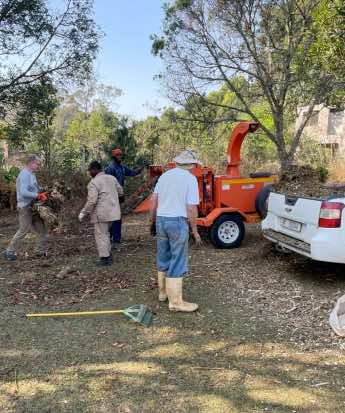 The chipper at work on alter-flowers and assorted garden refuse
The chipper at work on alter-flowers and assorted garden refuseA thought, an idea and finally it turned into an opportunity. Three months of hard work by many parishioners finally sorted the sheep from the goats, so to speak; the alter-flower compost from the tin cans, glass bottles and plastic bags.
What I thought was the final act was hiring a giant chipper that turned the remains of all those alter-flowers and assorted garden refuse into a massive pile of the most beautiful holy compost.
But it was not the final act. Surprisingly not many parishioners wanted any of the holy compost. Few were vegetable gardeners and those that were, already considered they were producing enough of their own; as in fact we thought. So what were we going to do? Should we pay a garden refuse man a fortune to cart it off to the municipal dump?
It raised an interesting conundrum for our family. We were already producing a mountain of compost in our green garden. Can you have too much? Could we use it as a mulch?
Well the long and the short of it, was shovelling 17 heaped loads onto our old bakkie, barrowing it down the garden and using it to heap up and mulch the seed potatoes that were just poking their heads through the soil.

Potatoes get bad press. They’re fattening carbs, right? And they are sprayed with Paraquat or Roundup just before harvesting to kill the haulm. We had friends to lunch this weekend. They never buy potatoes; and at first were reluctant to join me in lifting a few kilograms and taking them home. After tasting the Swiss rösti they very quickly changed their minds.
So what’s the story about potatoes? Should we all be banting and are they really a dreadful pseudo carb that health conscious people should be avoiding at all costs? Will they turn us into type-2 diabetics?
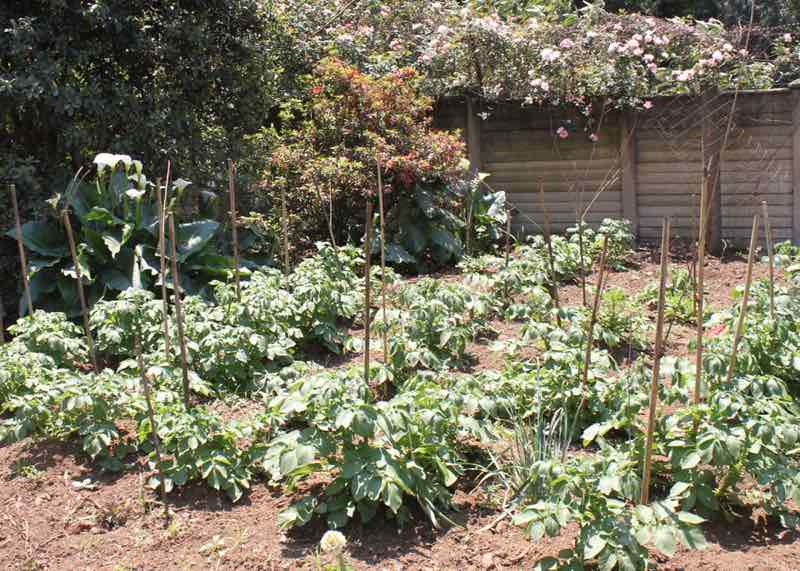
"There are between five and ten times more antioxidant compounds in the skin as in the flesh of potatoes; and a great source of fibre."
- University of Maine, Agriculture and Water Quality
Firstly these are new potatoes, freshly lifted from the ground. Like all veggies they lose their quality quite quickly. They are as different as a crunchy apple just picked from the tree compared with the soft starchy fruit that you find on the supermarket shelves six months after harvesting.
The test for a new potato by the way is that you can easily scrape the skin off with your thumbnail; they don’t need to be peeled. That alone is a huge plus because many of the antioxidants, much of the fibre and most of minerals are found in and just under the skin.
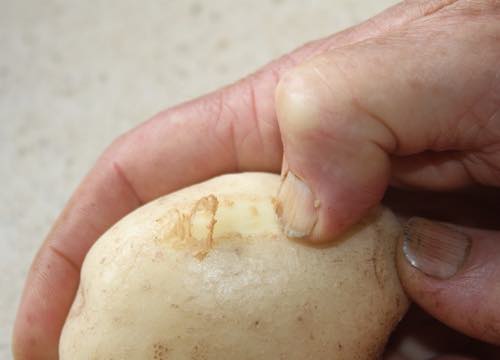
Antioxidants
Researchers from the University of Maine have found that new potatoes have up to ten times the amount of antioxidants; they are the nutrients that scavenge the “reactive oxygen species” that do so much damage to our genes causing cancer.
"The younger the new potato, the higher the ratio of skin to tuber content; and the greater the total amount of antioxidant found."
- University of Maine, Agriculture and Water Quality
Resistant starch and fibre
Thirdly new potatoes contain a large amount of “resistant starch.” The molecules link together in a fashion that dampens the effect of the digestive enzymes that turn carbs into glucose in the gut. Even diabetics may find that they can enjoy a small helping of new spuds without having to give themselves an extra squirt of insulin.
That resistant starch instead, along with the indigestible fibre passes through the small intestine to the colon where it provides exactly what the microbiome, the friendly bugs in the gut, need. Unpeeled potatoes are an extremely good source. Less than 5% of those eating typical supermarket food are getting the recommended daily allowance; with terrible consequences for the alimentary canal and our immune systems.
Protein, vitamins and minerals
Two medium-sized spuds contain about a 10% of the protein that an average adult needs every day; a lot more than expected.
One potato with its skin contains 10% of the magnesium we absolutely must have for over 300 different essential biochemical reactions going on in the body; and 20 percent of the potassium, a mineral desperately needed to keep blood pressure down. I could go on about calcium and a heap of important vitamins. Spuds are good for us; provided they have been recently harvested, not those from cold-storage.
Less of other starches
Well for nearly three months now we have been making pigs of ourselves; we eat mainly what is in season at our green home. So it’s fried potatoes for breakfast, Swiss rösti and Yiddish latkes for lunch; and simple boiled spuds with butter for supper. We have not gained an ounce. But quite naturally we have found the desire for bread and mealiemeal porridge has diminished.
Half a ton of potatoes
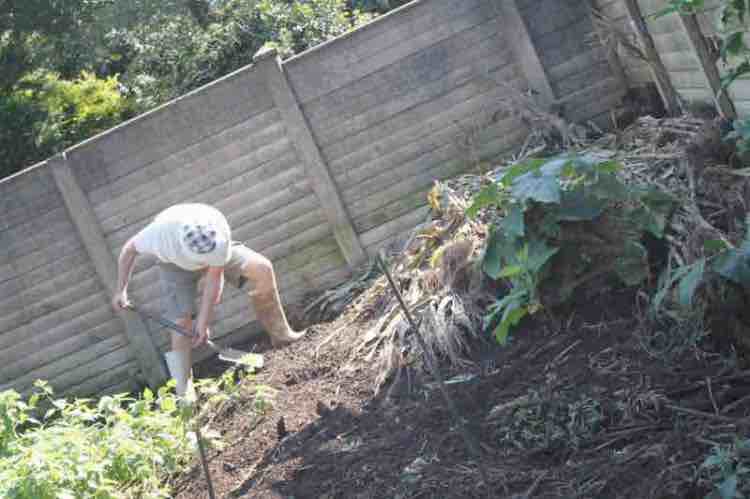 Gardening is hard work
Gardening is hard workAt our green home, in an ordinary suburban backyard but with two avid gardeners hard at work every day, we have at least half a ton of spuds and probably double that; we are not weighing. I'm not exaggerating; holy potatoes that do not make you fat! And supply us with large amounts of important nutrients. Alas I cannot say the same for French fries.
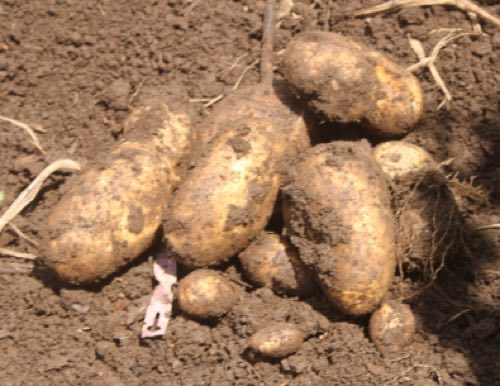 Giant organic potatoes; the heaviest 700g.
Giant organic potatoes; the heaviest 700g.But I kid you not, growing potatoes is hard work; but lifting them is like the joy of an Easter egg hunt every morning. The earthworms abound like I have never witnessed before. The hens too eat sumptuously as I dig. You’ll get plenty of vitamin D from the sunshine but always wear a hat obviously; and be careful not to spike your foot with the garden fork.
Growing more food that we can possibly ever eat, nutritious and fresh is our joy; free from toxic poisons too. Late summer is also a good time to plant potatoes that will grow through the winter unless you have heavy frosts.
Holy potatoes grown in alter-flower compost were a once off; an opportunity never to be repeated. You simply cannot have too much mulch in the garden; 17 heaped bakkie loads. Gardening on this scale is not for sissies but it does beat going to the gym.
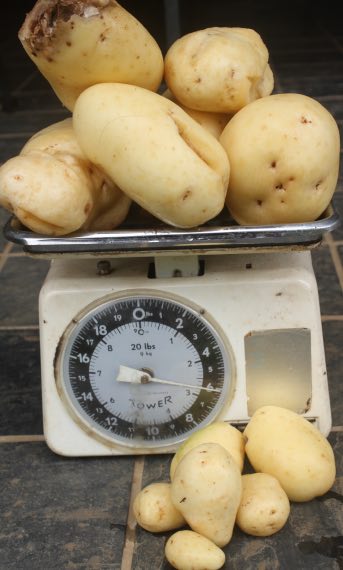 Astonishing harvest of organic potatoes; 3.2kg.
Astonishing harvest of organic potatoes; 3.2kg.A mole took a fancy to one of them. The King's Taster, he declares no Paraquat or Roundup was used in this garden; a friend in fact, aerating the soil and consuming many unfriendly bugs.
Those who are overweight or know they have suffer from insulin resistance should stick to the smaller ones; they have more resistant starch.
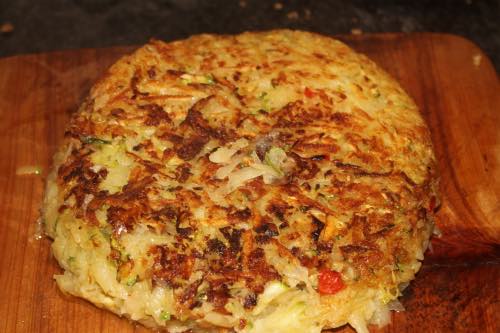 Swiss rösti
Swiss röstiHoly potatoes grown in alter-flower compost
Potatoes get bad press; everything depends on how long they have been in cold storage and in what way they are cooked. Cooling overnight allows the starch to retrograde, reducing the GI further.
- What is the quality test of carbohydrates?
- Influence of carbohydrate consumption on pancreatic function
Holy potatoes grown in alter-flower compost have a low GI.
When browsing use right click and "Open Link in New Tab" or you may get a bad gateway signal.
Newsletter
Our newsletter is entitled "create a cyan zone" at your home, preserving both yourself and Mother Earth for future generations; and the family too, of course. We promise not to spam you with daily emails promoting various products. You may get an occasional nudge to buy one of my books.
Here are the back issues.
- Lifestyle and ideal body weight
- What are ultra-processed foods?
- Investing in long-term health
- Diseases from plastic exposure
- Intensive lifestyle management for obesity has limited value
- A world largely devoid of Parkinson's Disease
- The impact of friendly bacteria in the tum on the prevention of cancer
- There's a hole in the bucket
- Everyone is talking about weight loss drugs
- Pull the sweet tooth
- If you suffer from heartburn plant a susu
- Refined maize meal and stunting
- Should agriculture and industry get priority for water and electricity?
- Nature is calling
- Mill your own flour
- Bake your own sourdough bread
- Microplastics from our water
- Alternative types of water storage
- Wear your clothes out
- Comfort foods
- Create a bee-friendly environment
- Go to bed slightly hungry
- Keep bees
- Blue zone folk are religious
- Reduce plastic waste
- Family is important
- What can go in compost?
- Grow broad beans for longevity
- Harvest and store sunshine
- Blue zone exercise
- Harvest and store your rainwater
- Create a cyan zone at your home
Did you find this page interesting? How about forwarding it to a friendly book or food junkie? Better still, a social media tick would help.
- Bernard Preston homepage
- Potatoes
- Holy Potatoes Grown in Alter-flower Compost
Address:
56 Groenekloof Rd,
Hilton, KZN
South Africa
Website:
https://www.bernard-preston.com